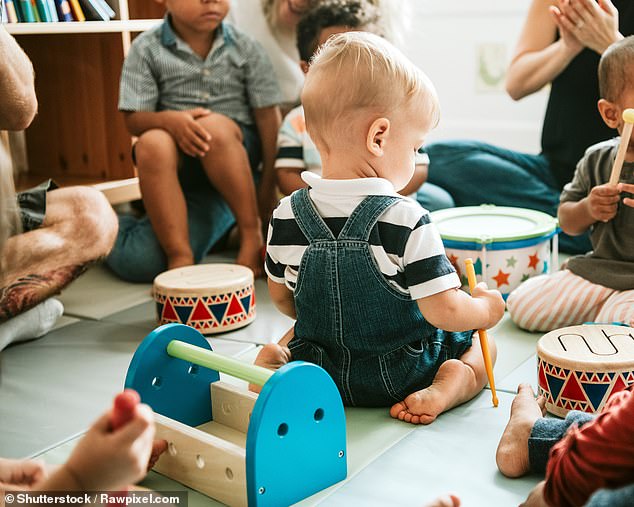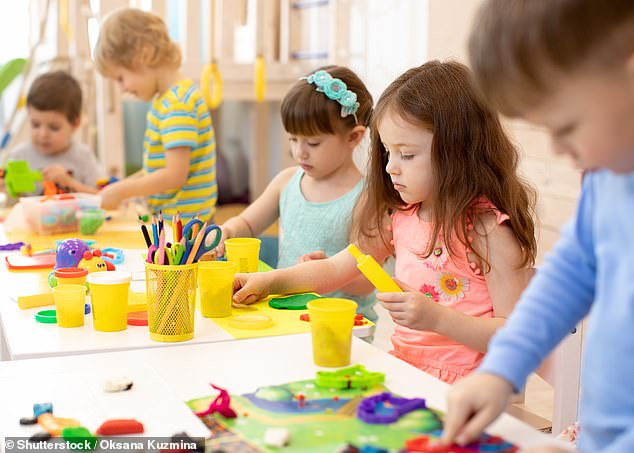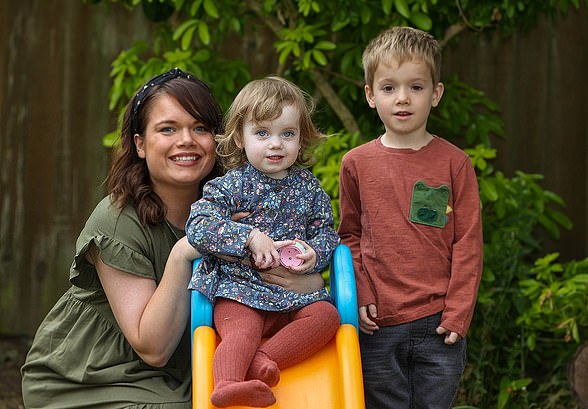CHILDCARE costs have reached crisis point. Parents say they are being forced to sacrifice their careers, while underfunded pre-schools are closing at record rates.
Yet Money Mail can today reveal that parents are missing out on nearly £3 billion in vital childcare support every year.
The tax-free childcare scheme tops up 20p to every 80p parents spend on nannies and nurseries — the equivalent of the basic-rate of income tax. It offers a maximum saving of £2,000 per child each year — or £4,000 for a disabled child.

Untapped support: Tax-free childcare scheme tops up 20p to every 80p parents spend on nannies and nurseries. It offers a maximum saving of £2,000 per child each year
But while the perk is available to 1.7 million children under the age of five, take-up of the scheme has remained pitifully low since it was introduced in 2017.
Fewer than 300,000 have an account in use — less than a quarter of the total eligible for help, according to March 2021 data provided by HM Revenue & Customs in response to a parliamentary question.
A further 225,000 have an account open but not in use, which could be because they do not use it regularly.
The government also spent £650 million less than expected on the scheme in the 2019/2020 financial year. If all eligible families who do not currently benefit from the perk signed up overnight it would cost the Treasury an extra £2.8 billion a year, the figures show.
Critics say not enough is being done to raise awareness of the scheme.
Many parents complain they were never informed about it and only stumbled across it after speaking to friends or when doing their own research.
Official figures show that in 2018/19, the government spent £1,113,270 publicising the perk.
But by 2020/21, this figure had dropped to £197,338. And for 2021/22, the government is forecast to spend only £151,205.
What’s more the application process can be confusing and protracted — with parents asked to reapply every three months.
Labour MP Stella Creasy has been a vocal advocate for working parents and drew headlines when she brought her three-month-old son strapped onto her chest to a debate in the Commons in November last year.
She says: ‘The problem with tax-free childcare is that most parents simply do not know it exists. Either the government needs to raise awareness of the scheme or they need to take the funds available for it and come up with a better system.
‘I am not asking the government for any new money. I am asking for parents to get their money back.’
She adds: ‘Childcare costs have risen at four times the rate of wages over the last two decades. For most parents, these costs take up a massive chunk of their cost of living.’

And with families facing a cost of living crisis, as a perfect storm of price rises and tax hikes squeeze their budgets to breaking point, they have never needed help with childcare costs more.
Neil Leitch, chief executive of the Early Years Alliance, says: ‘With the tax-free childcare scheme still struggling with low uptake several years after being introduced, it beggars belief that the government would not choose to reinvest the underspend from this scheme back into the early years sector.’
For Joeli Brearley, founder of campaigning group Pregnant Then Screwed, the application process can be enough to put parents off.
She says: ‘I remember when I was applying for tax-free childcare I wanted to throw the computer out of the window.
‘I hear that from a lot of parents who say the application form is very long and requires a lot of detail. You also have to reapply every three months.’
The average annual price of a nursery place now stands at £14,000 per child — more expensive than university tuition fees.
And it is often mothers who are hit hardest by spiralling nursery costs.

As well as day-to-day childcare, the scheme also covers holiday activities such as art clubs
Figures from Pregnant Then Screwed say there are around 870,000 stay-at-home mums in the UK who want to go back to work but cannot afford to do so.
A third either pay to go to work - because their childcare outgoings exceed their wage — or only just break even.
Ms Brearley says: ‘Many mothers I know end up paying to go to work because they can’t give it up.’
And the pandemic has only exacerbated the situation.
A study by charity The Fawcett Society in 2020 found that a third of working mothers reported losing work or hours due to a lack of childcare during lockdown.
At the same time, nurseries have also struggled to stay open, with 2,549 childcare settings closed down between December 2020 and March 2021.
Currently only 0.5 per cent of GDP in the UK is spent on early childhood services.
By comparison 1.1 per cent of GDP is spent on subsidising childcare in Nordic nations such as Denmark and Sweden.
‘We are constantly talking about how expensive university fees are and whether they are worth the money.
But we never talk about childcare in the same way,’ says mother Rachel Carrell, who set up her own childcare app Koru Kids to offer an affordable solution.
‘Couples often go into parenthood blind and are shocked to find out just how expensive childcare is.
‘Many people I speak to really do feel they’ve been priced out of parenthood.’
HMRC says figures from September show 316,000 families accessed the tax-free childcare scheme.
A spokesman says: ‘Tax-free childcare is a great offer for working parents providing financial support with their childcare costs.
‘More and more families are benefitting from the offer with close to 50pc more families taking advantage of it compared to March 2020.
‘We consistently encourage eligible families to sign up for the scheme via stakeholders, social media and the press and will continue to explore ways to further increase take-up.’
Some links in this article may be affiliate links. If you click on them we may earn a small commission. That helps us fund This Is Money, and keep it free to use. We do not write articles to promote products. We do not allow any commercial relationship to affect our editorial independence.



